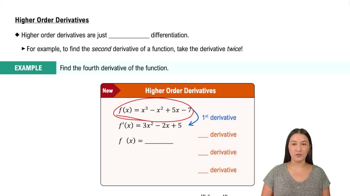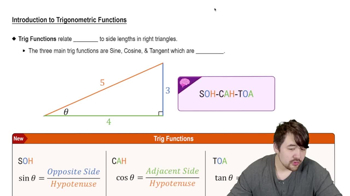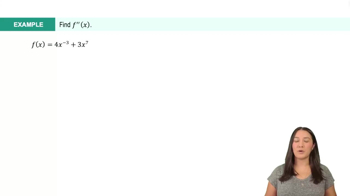Table of contents
- 0. Functions7h 52m
- Introduction to Functions16m
- Piecewise Functions10m
- Properties of Functions9m
- Common Functions1h 8m
- Transformations5m
- Combining Functions27m
- Exponent rules32m
- Exponential Functions28m
- Logarithmic Functions24m
- Properties of Logarithms34m
- Exponential & Logarithmic Equations35m
- Introduction to Trigonometric Functions38m
- Graphs of Trigonometric Functions44m
- Trigonometric Identities47m
- Inverse Trigonometric Functions48m
- 1. Limits and Continuity2h 2m
- 2. Intro to Derivatives1h 33m
- 3. Techniques of Differentiation3h 18m
- 4. Applications of Derivatives2h 38m
- 5. Graphical Applications of Derivatives6h 2m
- 6. Derivatives of Inverse, Exponential, & Logarithmic Functions2h 37m
- 7. Antiderivatives & Indefinite Integrals1h 26m
- 8. Definite Integrals4h 44m
- 9. Graphical Applications of Integrals2h 27m
- 10. Physics Applications of Integrals 2h 22m
3. Techniques of Differentiation
Higher Order Derivatives
Problem 3.5.79.b
Textbook Question
A differential equation is an equation involving an unknown function and its derivatives. Consider the differential equation y′′(t)+y(t) = 0.
b. Show that y = B cos t satisfies the equation for any constant B.
 Verified step by step guidance
Verified step by step guidance1
Start by understanding the differential equation y''(t) + y(t) = 0, where y''(t) is the second derivative of y with respect to t.
Consider the proposed solution y(t) = B cos(t), where B is a constant. We need to verify that this function satisfies the differential equation.
Calculate the first derivative of y(t) = B cos(t) with respect to t. The derivative of cos(t) is -sin(t), so y'(t) = -B sin(t).
Calculate the second derivative of y(t) = B cos(t). The derivative of -B sin(t) is -B cos(t), so y''(t) = -B cos(t).
Substitute y(t) = B cos(t) and y''(t) = -B cos(t) into the differential equation y''(t) + y(t) = 0. This gives -B cos(t) + B cos(t) = 0, which simplifies to 0 = 0, confirming that y = B cos(t) satisfies the equation for any constant B.
 Verified video answer for a similar problem:
Verified video answer for a similar problem:This video solution was recommended by our tutors as helpful for the problem above
Video duration:
11mPlay a video:
Was this helpful?
Key Concepts
Here are the essential concepts you must grasp in order to answer the question correctly.
Differential Equations
A differential equation is a mathematical equation that relates a function to its derivatives. It describes how a quantity changes over time or space, and can be classified into ordinary differential equations (ODEs) and partial differential equations (PDEs) based on the number of independent variables involved.
Recommended video:

Finding Differentials
Second-Order Derivatives
In the context of differential equations, a second-order derivative refers to the derivative of a derivative, indicating how the rate of change of a function itself changes. For example, in the equation y''(t), the notation signifies the second derivative of the function y with respect to the variable t, which is crucial for analyzing the behavior of the function.
Recommended video:

Higher Order Derivatives
Trigonometric Functions
Trigonometric functions, such as sine and cosine, are fundamental periodic functions that arise in various mathematical contexts, including solutions to differential equations. The function y = B cos(t) represents a cosine wave, where B is a constant that affects the amplitude, and it is often used to express solutions to second-order linear differential equations with constant coefficients.
Recommended video:

Introduction to Trigonometric Functions

 2:42m
2:42mWatch next
Master Higher Order Derivatives with a bite sized video explanation from Callie
Start learningRelated Videos
Related Practice



